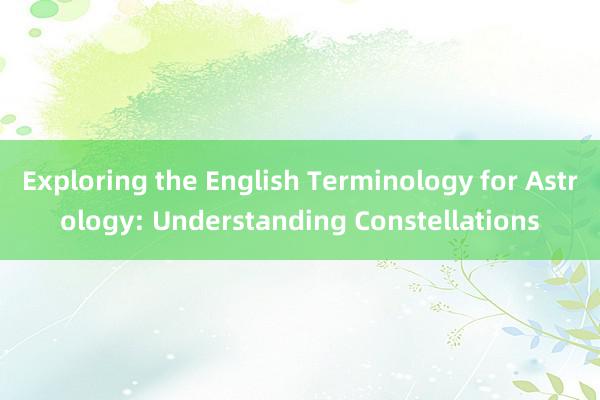时间:2024-10-29 11:25

### Exploring the English Terminology for Astrology: Understanding Constellations
Astrology, the ancient practice of divining information about an individual's life and personality through the positions of celestial bodies, has a rich history that spans across cultures and centuries. At its core, astrology relies on the interpretation of constellations, which are specific groupings of stars that form recognizable patterns in the night sky. Understanding these patterns is crucial to grasping the terminology used in astrology, particularly when discussing the zodiac signs.
#### 1. **The Zodiac and Its Constellations**
The zodiac, a fundamental component of astrology, is divided into twelve signs, each corresponding to a constellation in the sky. These signs are not only associated with dates but also represent different aspects of human nature and life experiences. The twelve constellations include Aries, Taurus, Gemini, Cancer, Leo, Virgo, Libra, Scorpio, Sagittarius,企业-伊家吉咖啡有限公司 Capricorn, 陆家嘴游艇俱乐部 Aquarius, 首页-盛 吉圣 锁具有限公司 and Pisces. Each constellation has its own mythological story and astrological significance.
#### 2. **Celestial Mechanics and Constellations**
Constellations are formed by clusters of stars that appear to be grouped together from Earth’s perspective. These stars are not physically connected; rather, they are simply aligned in the sky, creating patterns that have been observed and named by various civilizations. The movement of the Earth around the Sun causes the apparent motion of the constellations across the sky, a phenomenon known as precession.
#### 3. **The Role of Constellations in Astrology**
In astrology, the positions of the constellations at the time of a person’s birth are believed to influence their character traits, life events,丹阳市大华实业有限公司 and future. The zodiac signs, derived from these constellations, are used to interpret a person’s horoscope. Each sign is associated with certain qualities, strengths, and weaknesses, providing a framework for understanding personal characteristics and potential life paths.
#### 4. **The Evolution of Astrological Terminology**
Over time, the language of astrology has evolved, incorporating both traditional and modern terms. For instance, the term "ascendant" (or "rising sign") refers to the constellation that was on the eastern horizon at the time of a person's birth, influencing one’s public persona and how others perceive them. Similarly, "midheaven" or "zenith" signifies the highest point in the sky, often associated with career and professional aspirations.
成都锦润实业发展有限公司#### 5. **Cross-Cultural Perspectives on Constellations**
Across different cultures, constellations have various names and stories, reflecting diverse mythologies and astronomical observations. For example, the constellation Orion is recognized in many cultures, including Greek, Arabic, and Chinese, each with its own tales and associations. Understanding these cross-cultural perspectives enriches the study of astrology, highlighting the universal yet culturally nuanced nature of celestial observation.
#### Conclusion
Exploring the English terminology for astrology and understanding the significance of constellations is not just about learning a set of words; it’s about delving into a rich tapestry of cultural knowledge, historical insights, and personal interpretations. By recognizing the constellations and their zodiac signs丹阳市大华实业有限公司, one can gain a deeper appreciation for the intricate connections between the cosmos and human destiny, fostering a holistic view of the universe and our place within it.